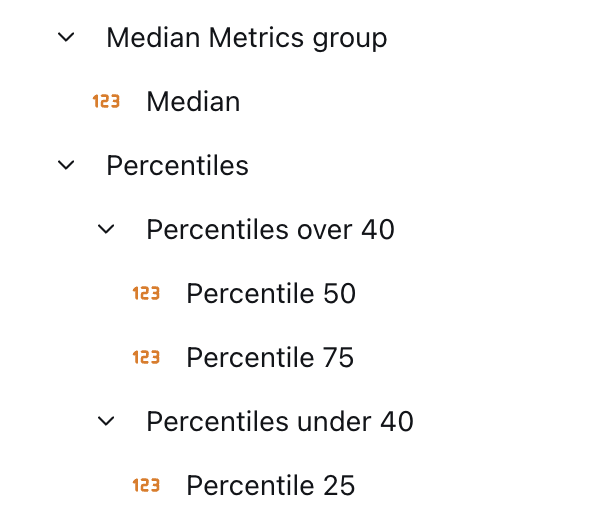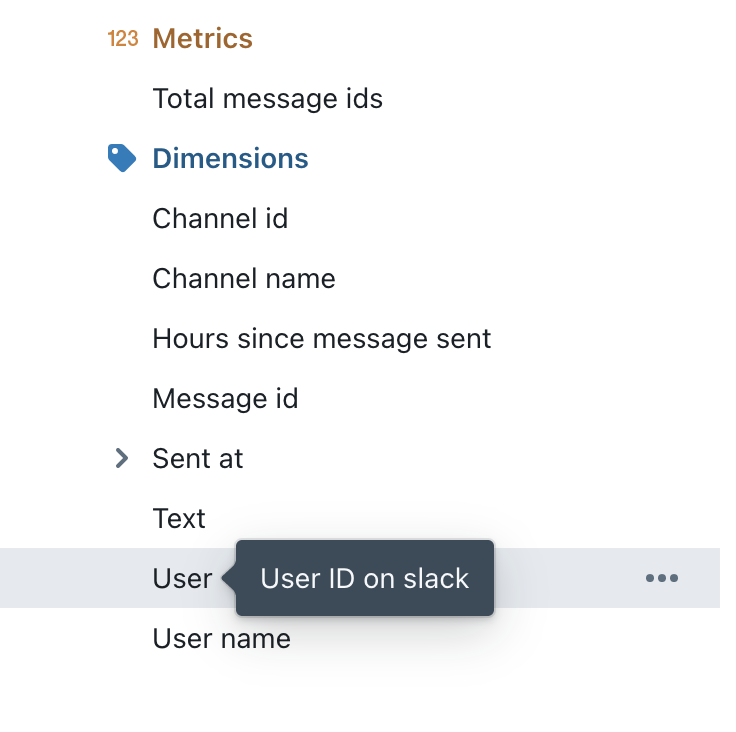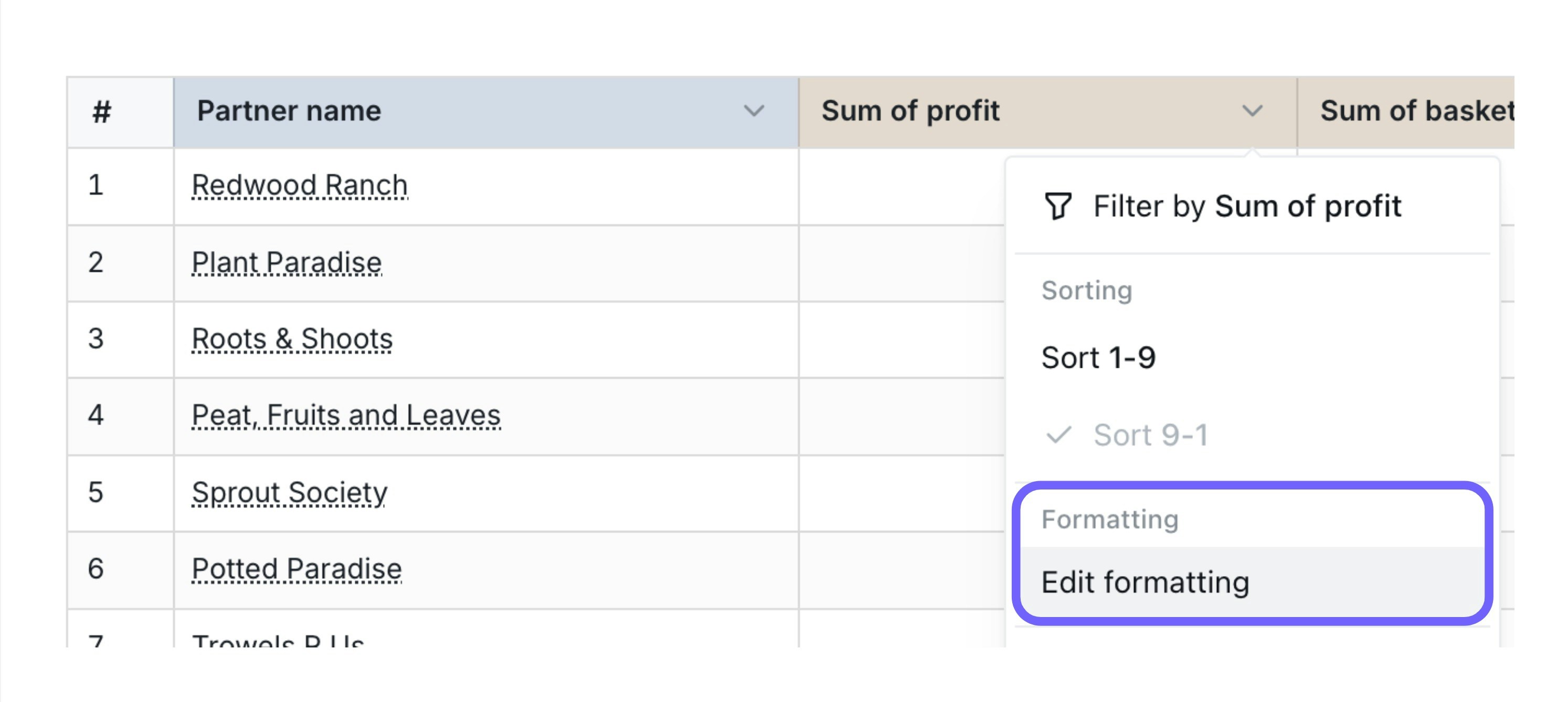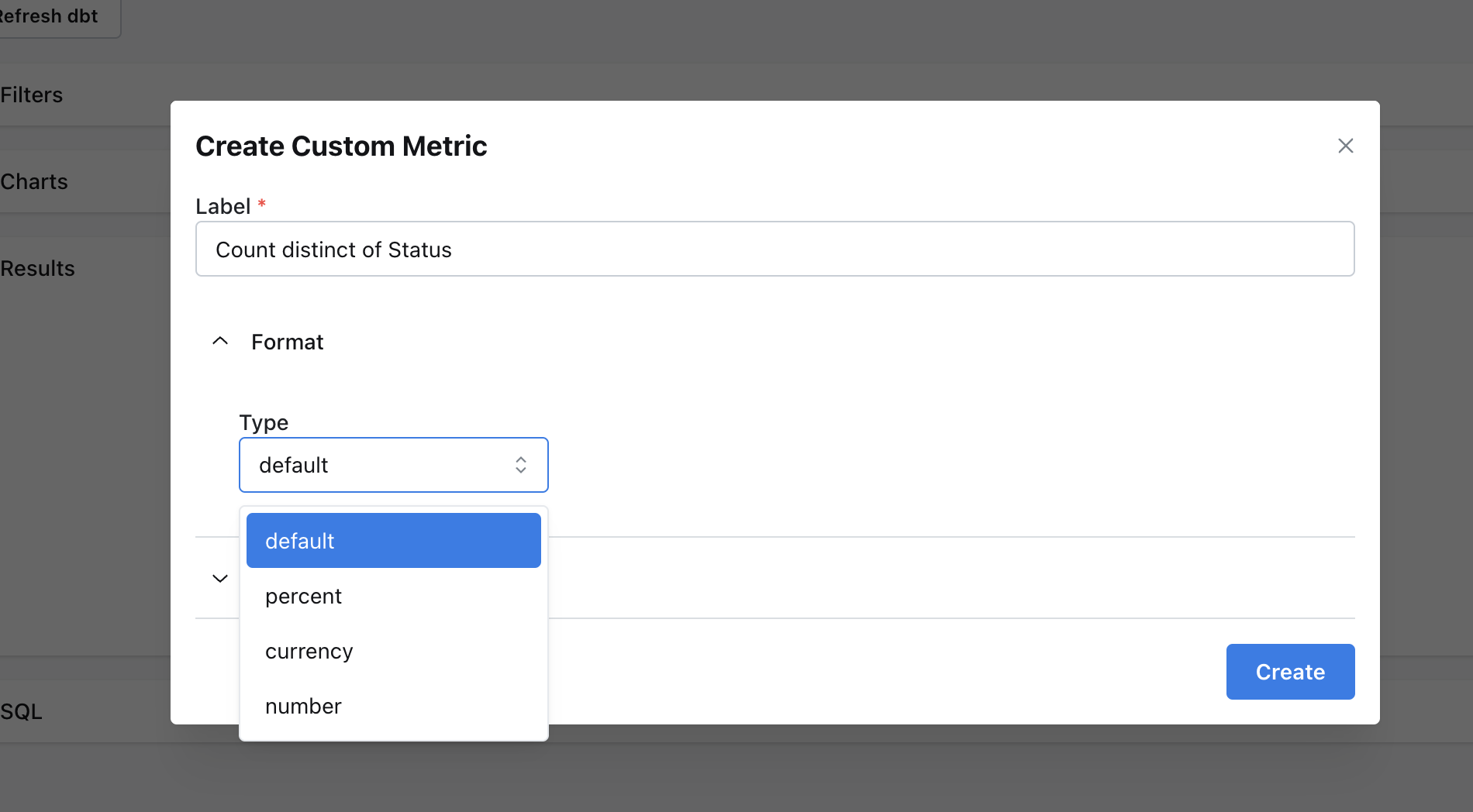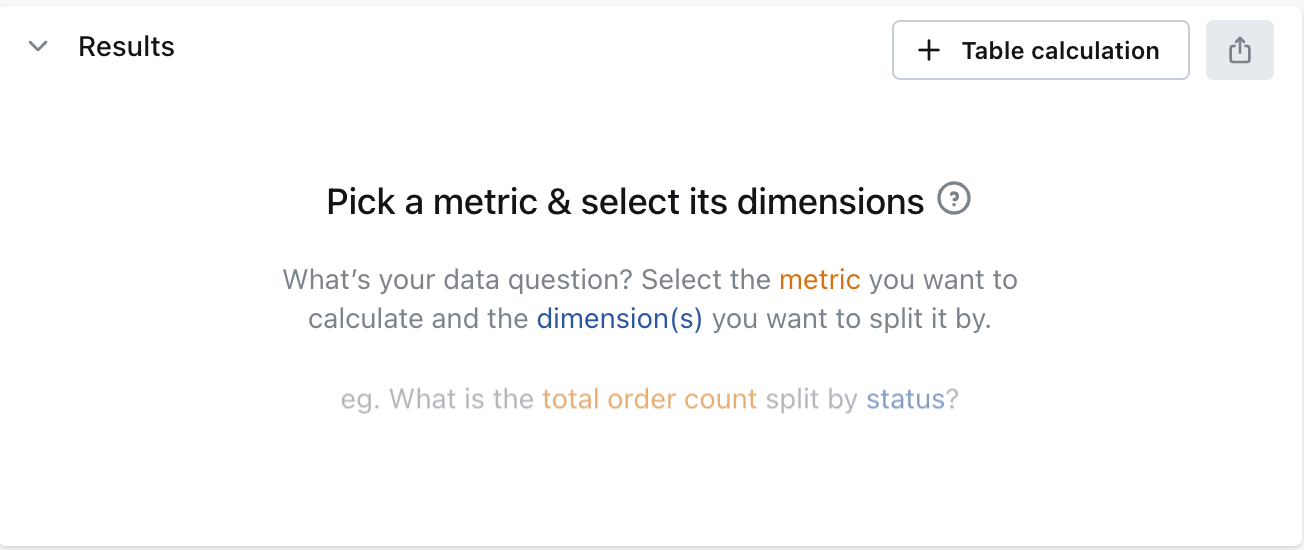Sometimes the format of things in your dbt project is different to how you want it to look in Lightdash. That’s okay! We’ve built a bunch of features to help you to format the fields in your dbt project so that the data in your Lightdash project looks exactly like you want it to 🥸
We’re going to go through formatting your fields in more detail below, but you can see a list of these configurations and all of the other properties you can customize for your fields in the dimensions reference doc and metrics reference doc.
Hiding fields
Sometimes, we have a bunch of columns in our YAML files that we might not want to include in Lightdash. For example, columns with PII data, or the same date data, but at different levels of date granularity.
It’s easy to hide columns from Lightdash. All you need to do is add two words to your column: hidden: true.
In your dbt YAML file, it’ll look something like this:
dbt v1.9 and earlier
dbt v1.10+ and Fusion
models:
- name: users
columns:
- name: first_name
meta:
dimension:
hidden: true
models:
- name: users
columns:
- name: first_name
config:
meta:
dimension:
hidden: true
dbt v1.9 and earlier
dbt v1.10+ and Fusion
models:
- name: users
columns:
- name: first_name
meta:
metrics:
count_unique_first_names:
type: count_distinct
hidden: true
models:
- name: users
columns:
- name: first_name
config:
meta:
metrics:
count_unique_first_names:
type: count_distinct
hidden: true
hidden: false.
You can group related metrics and dimensions together using the model meta group_details block in combination with the groups property in your .yaml files. You can as well add descriptions to your groups using the property description that will be displayed when hovering over the group label.
Max grouping levels.There is a max of 2 levels of grouping in the sidebar.
group property to your metrics like so:
dbt v1.9 and earlier
dbt v1.10+ and Fusion
models:
- name: events
meta:
group_details:
events:
label: Events
description: Event-related fields.
percentile:
label: Percentiles
description: Grouping of percentiles
sub:
label: Percentiles under 40
description: Grouping of percentiles under 40
over:
label: Percentiles over 40
description: Grouping percentiles over 40
columns:
- name: event_id
description: ''
meta:
dimension:
type: number
groups: ['events']
metrics:
percentile_25:
type: percentile
percentile: 25
groups: ['percentile', 'sub']
percentile_50:
type: percentile
percentile: 50
groups: ['percentile', 'over']
percentile_75:
type: percentile
percentile: 75
groups: ['percentile', 'over']
models:
- name: events
config:
meta:
group_details:
events:
label: Events
description: Event-related fields.
percentile:
label: Percentiles
description: Grouping of percentiles
sub:
label: Percentiles under 40
description: Grouping of percentiles under 40
over:
label: Percentiles over 40
description: Grouping percentiles over 40
columns:
- name: event_id
description: ''
config:
meta:
dimension:
type: number
groups: ['events']
metrics:
percentile_25:
type: percentile
percentile: 25
groups: ['percentile', 'sub']
percentile_50:
type: percentile
percentile: 50
groups: ['percentile', 'over']
percentile_75:
type: percentile
percentile: 75
groups: ['percentile', 'over']
metrics section, and your dimensions will get grouped together under your label in the dimensions section.
Adding custom descriptions
Dimensions
By default, Lightdash pulls in the descriptions you’ve included for your dimensions. But, you can override the description you see in Lightdash using the description property.
dbt v1.9 and earlier
dbt v1.10+ and Fusion
models:
- name: users
columns:
- name: user_id
description: "Id generated by the Lightdash API on user's first login. On legacy systems, SHA64. On new systems since 2012, FARM_FINGERPRINT()"
meta:
dimension:
description: 'Unique identifier for a user'
models:
- name: users
columns:
- name: user_id
description: "Id generated by the Lightdash API on user's first login. On legacy systems, SHA64. On new systems since 2012, FARM_FINGERPRINT()"
config:
meta:
dimension:
description: 'Unique identifier for a user'
Metrics
If you don’t add a custom description for your metric, Lightdash will show a description for you in the app, by default. To override this default description, you can use the description property.
dbt v1.9 and earlier
dbt v1.10+ and Fusion
models:
- name: users
columns:
- name: user_id
description: "Id generated by the Lightdash API on user's first login. On legacy systems, SHA64. On new systems since 2012, FARM_FINGERPRINT()"
meta:
metrics:
count_unique_users:
type: count_distinct
description: 'Count the unique number of user IDs'
models:
- name: users
columns:
- name: user_id
description: "Id generated by the Lightdash API on user's first login. On legacy systems, SHA64. On new systems since 2012, FARM_FINGERPRINT()"
config:
meta:
metrics:
count_unique_users:
type: count_distinct
description: 'Count the unique number of user IDs'
Renaming fields
Sometimes, the labels we use for the fields in our dbt project aren’t very user friendly. We might want to change these in Lightdash, and we can!
To change the name you’ll see for your field in Lightdash, you just use the label property.
So, if I had a field user_id_sha64, I could relabel it to User ID.
dbt v1.9 and earlier
dbt v1.10+ and Fusion
models:
- name: users
columns:
- name: user_id_sha64
meta:
dimension:
label: 'User ID'
models:
- name: users
columns:
- name: user_id_sha64
config:
meta:
dimension:
label: 'User ID'
Relabelling a metric will not break any saved charts that use the old metric name. Instead, your saved charts will just use the new metric name in their results tables.
dbt v1.9 and earlier
dbt v1.10+ and Fusion
models:
- name: users
columns:
- name: user_id_sha64
meta:
metrics:
count_unique_user_ids:
type: count_distinct
label: 'Total users'
models:
- name: users
columns:
- name: user_id_sha64
config:
meta:
metrics:
count_unique_user_ids:
type: count_distinct
label: 'Total users'
Rounding
Rounding your metrics is easy to do using the format property in your YAML file.
Here’s an example of how different rounding will affect your numbers:
| Original number | Format value | How it will appear in Lightdash |
|---|
| 121.854 | ’0.00’ | 121.85 |
| 121.854 | ’0.0’ | 121.9 |
| 121.854 | ’0’ | 123 |
Rounding dimensions
Like this:
dbt v1.9 and earlier
dbt v1.10+ and Fusion
models:
- name: sales
columns:
- name: revenue
meta:
dimension:
format: '0.00'
models:
- name: sales
columns:
- name: revenue
config:
meta:
dimension:
format: '0.00'
Rounding metrics
Like this:
dbt v1.9 and earlier
dbt v1.10+ and Fusion
models:
- name: sales
columns:
- name: revenue
meta:
metrics:
total_revenue:
type: sum
format: '0.00'
models:
- name: sales
columns:
- name: revenue
config:
meta:
metrics:
total_revenue:
type: sum
format: '0.00'
Compacting big numbers
Here’s an example of how different compacting will affect your numbers:
| Original number | Format value | How it will appear in Lightdash |
|---|
| 1000000000 | ’0’ | 1000000000 |
| 1000000000 | ’0,” K“‘ | 1000000K |
| 1000000000 | ’0,,” M“‘ | 1000M |
Compact dimensions
Like this:
dbt v1.9 and earlier
dbt v1.10+ and Fusion
models:
- name: sales
columns:
- name: revenue
meta:
dimension:
format: '0," K"'
models:
- name: sales
columns:
- name: revenue
config:
meta:
dimension:
format: '0," K"'
Compact metrics
Like this:
dbt v1.9 and earlier
dbt v1.10+ and Fusion
models:
- name: sales
columns:
- name: revenue
meta:
metrics:
total_revenue:
type: sum
format: '0.00,,," B"'
models:
- name: sales
columns:
- name: revenue
config:
meta:
metrics:
total_revenue:
type: sum
format: '0.00,,," B"'
Add units to your values
Some columns need a special format to convey what units they’re in. For example, if you’re a global company, and you have a revenue field. Is that in GBP? USD?
In Lightdash, you can use the format label to add units to your fields.
Here’s an example of how different formats will affect your values:
| Original value | Format value | How it will appear in Lightdash |
|---|
| 121.854 | ’[$£]#,##0.00’ | £121.85 |
| 121.854 | ’$#,##0.00’ | $121.90 |
Add units to dimensions
You can add a format to your dimensions this:
dbt v1.9 and earlier
dbt v1.10+ and Fusion
models:
- name: sales
columns:
- name: revenue
meta:
dimension:
format: '[$£]#,##0.00'
models:
- name: sales
columns:
- name: revenue
config:
meta:
dimension:
format: '[$£]#,##0.00'
Add units to metrics
You can add a format to your metrics this:
dbt v1.9 and earlier
dbt v1.10+ and Fusion
models:
- name: sales
columns:
- name: revenue
meta:
metrics:
total_revenue:
type: sum
format: '[$£]#,##0.00'
models:
- name: sales
columns:
- name: revenue
config:
meta:
metrics:
total_revenue:
type: sum
format: '[$£]#,##0.00'
Simple parameter substitution
You can reference parameter values directly in your format strings using the syntax ${ld.parameters.parameterName}.
For example, if you have a parameter called currency_symbol, you can use it in your format like this:
Step 1: Define your parameter
In your lightdash.config.yml file:
parameters:
currency_symbol:
label: "Currency symbol"
description: "Conditional formatting for currency symbol"
default: "$"
options:
- "$"
- "€"
dbt v1.9 and earlier
dbt v1.10+ and Fusion
models:
- name: sales
columns:
- name: revenue
meta:
metrics:
total_revenue:
type: sum
format: '${ld.parameters.currency_symbol}0,0.00'
models:
- name: sales
columns:
- name: revenue
config:
meta:
metrics:
total_revenue:
type: sum
format: '${ld.parameters.currency_symbol}0,0.00'
'${ld.parameters.currency_symbol}0,0.00' will substitute the selected currency symbol value directly into the format.
When users select $ from the parameter dropdown, numbers will display as $1,234.56. When they select €, numbers will display as €1,234.56.
For more complex formatting logic, you can use ternary expressions in your format strings. The syntax is:
${ld.parameters.parameterName=="value"?"format_if_true":"format_if_false"}
currency parameter:
Step 1: Define your parameter
In your lightdash.config.yml file:
parameters:
currency:
label: "Currency"
description: "Conditional formatting for currency"
default: "usd"
options:
- "usd"
- "eur"
- "gbp"
dbt v1.9 and earlier
dbt v1.10+ and Fusion
models:
- name: sales
columns:
- name: revenue
meta:
metrics:
total_revenue:
type: sum
format: '${ld.parameters.currency=="usd"?"$":""}${ld.parameters.currency=="eur"?"€":""}${ld.parameters.currency=="eur"?"£":""}0,0.00'
models:
- name: sales
columns:
- name: revenue
config:
meta:
metrics:
total_revenue:
type: sum
format: '${ld.parameters.currency=="usd"?"$":""}${ld.parameters.currency=="eur"?"€":""}${ld.parameters.currency=="eur"?"£":""}0,0.00'
- When
currency is "usd", displays $1,234.56
- When
currency is "eur", displays €1,234.56
- When
currency is "gbp", displays £1,234.56
Another example: Controlling decimal places
You can use conditional formatting to toggle between different precision levels.
Define your parameter in lightdash.config.yml:
parameters:
decimals:
label: "Decimals"
description: "Conditional formatting for decimals"
default: "true"
options:
- "true"
- "false"
dbt v1.9 and earlier
dbt v1.10+ and Fusion
models:
- name: sales
columns:
- name: revenue
meta:
metrics:
total_revenue:
type: sum
format: '0,0${ld.parameters.decimals=="true"?".00":""}'
models:
- name: sales
columns:
- name: revenue
config:
meta:
metrics:
total_revenue:
type: sum
format: '0,0${ld.parameters.decimals=="true"?".00":""}'
decimals is "true", numbers display as $1,234.56. When decimals is "false", numbers display as $1,235.
You can also format your fields in the Lightdash UI. This is useful if you want to format your fields quickly without having to change your YAML files.
Currently you can format 2 types of fields in the Lightdash UI:
Metrics formatting is currently only available for numeric metric types.
-
percent: Formats your metric as a percentage, with the following options:
round value to your metric to round it to a certain number of decimal placesseparator, e.g. from . to ,
-
currency: Formats your metric as a currency
round value to your metric to round it to a certain number of decimal placesseparator, e.g. from . to ,currency symbol, e.g. from $ to £compact value to compact your metric to a certain unit, e.g. from 1,000,000 to 1M
-
number: Formats your metric as a number
round value to your metric to round it to a certain number of decimal placesseparator, e.g. from . to ,compact value to compact your metric to a certain unit, e.g. from 1,000,000 to 1Mprefix value to add a prefix to your metric, e.g. + or -suffix value to add a suffix to your metric, e.g. %
On the results table, you can add a table calculation by clicking on the button on the right hand side of the section.
Once you’ve created your table calculation, you can format it by clicking on the Format tab:
You can then choose from the following formatting types:
-
percent: Formats your metric as a percentage, with the following options:
round value to your metric to round it to a certain number of decimal placesseparator, e.g. from . to ,
-
currency: Formats your metric as a currency
round value to your metric to round it to a certain number of decimal placesseparator, e.g. from . to ,currency symbol, e.g. from $ to £compact value to compact your metric to a certain unit, e.g. from 1,000,000 to 1M
-
number: Formats your metric as a number
round value to your metric to round it to a certain number of decimal placesseparator, e.g. from . to ,compact value to compact your metric to a certain unit, e.g. from 1,000,000 to 1Mprefix value to add a prefix to your metric, e.g. + or -suffix value to add a suffix to your metric, e.g. %
